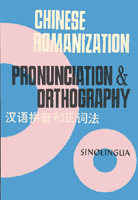 For several years I’ve had online the brief official principles for writing Hanyu Pinyin. But those go only so far. Fortunately, Yin Binyong (Yǐn Bīnyōng / 尹斌庸) (1930-2003), who was involved in work on Hanyu Pinyin from the beginning, wrote two books on the subject, producing a detailed, logical, and effective orthography for Pinyin.
For several years I’ve had online the brief official principles for writing Hanyu Pinyin. But those go only so far. Fortunately, Yin Binyong (Yǐn Bīnyōng / 尹斌庸) (1930-2003), who was involved in work on Hanyu Pinyin from the beginning, wrote two books on the subject, producing a detailed, logical, and effective orthography for Pinyin.
The only one of those two books with English explanations as well as Mandarin, Chinese Romanization: Pronunciation and Orthography (Mandarin title: Hànyǔ Pīnyīn hé Zhèngcífǎ / 汉语拼音和正词法 / 漢語拼音和正詞法), has gone out of print; and at present there are no plans to bring it back into print. Fortunately, however, I was eventually able to secure the rights to reproduce this work on Pinyin.Info. Yes, the entire book. So everybody be sure to say thank you to the generous publisher by buying Sinolingua’s books.
This book, which is nearly 600 pages long, is a mother lode of information. It would be difficult for me to overstate its importance. Over the next few months I’ll be releasing the work in sections. I had intended to delay this a little, as I have had to wait for a fancy new scanner and am still awaiting some OCR software that can handle Hanzi as well as the Roman alphabet. (This Web site is an expensive hobby!) But since Taiwan has recently adopted Hanyu Pinyin I will be releasing some material soon (without OCR, for the time being) in the hope of helping Taiwan avoid making mistakes in its implementation of an orthography for Pinyin here.
Watch this blog for updates.

Wow, great work! This is very exciting. I look forward to checking out the scans.
Pingback: Pinyin news » Hanyu Pinyin and proper nouns
Pingback: Links 22 September 2008 - David on Formosa
But what happens if the opposition party wins a future election and unadopts it? Hopefully you have this book’s Tongyong counterpart lying around somewhere…
Of course you jest. Standards? Tongyong Pinyin?
Anyway, this being Taiwan, if in the future some ruling party wants to continue the tradition of national madness when it comes to romanization, they’ll be sure to come up with another system.
I can hear the party leaders now. “Well, Tongyong Pinyin might have worked. But it lacked the important innovations of our new ‘Fubar Pinyin,’ which uses the percent sign and new Yangming Shan icon in linguistically significant ways that fully express Taiwan’s national identity.”
Then they’d have to redo the style of the signage as well. Perhaps rotate the signs 90 degrees clockwise to indicate places to the east, 90 degrees counterclockwise for places to the west, and upside down for places to the south….
Patiently waiting for the whole book to appear :) Isn’t there a grad student around willing learn valuable academic skills by scanning the whole book for the rest of us?
I’m working on getting the sections online faster than before. Counting the post that went up last night, I have four sections scheduled for release this week. Check the pinyin rules posts for the latest.